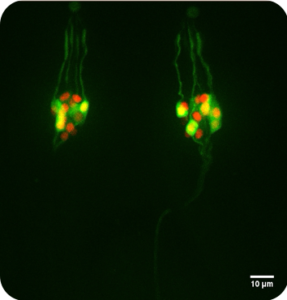by Jess Kanwal, Guangwei Si, and Aravi Samuel

Olfactory receptor neurons in a two day old fly larva. Red indicates cell bodies, green marks neurons activated by an odor.
As we walk towards a pot of brewing coffee, the intensity of its smell strengthens. Despite this change, we can easily recognize that all of the different intensities represent the smell of coffee and not any other foods. Previous work has shown that distinct odors activate distinct groups of olfactory receptor neurons (ORNs), the first set of neurons to detect odor molecules and relay this information to the rest of the brain. However, as the intensity of an odor increases so does the group of active neurons, raising the question: how does the brain separate changes in the type of smell from changes in the intensity of a smell?
To answer this question, we turned to the tiny fruit fly larva, an organism with relatively few ORNs. For the first time, we could measure the activity of an entire ORN population while simultaneously delivering different odors at varying intensities. We find that the larval ORN population represents odor based on the unique combination of each ORN’s sensitivity to that smell. Importantly, this sensitivity representation does not change with odor intensity. Furthermore, the intensity of an odor is well represented by the overall activity level of the entire ORN population. These findings are important in building our understanding of how the brain allows animals to distinguish different odors from one another while still maintaining the ability to represent a single odor across different intensities.
This work was supported in part by the HBI Collaborative Seed Grant Program.
To learn more, read the original research article in Neuron:
Structured Odorant Response Patterns across a Complete Olfactory Receptor Neuron Population. Si G, Kanwal JK, Hu Y, Tabone CJ, Baron J, Berck M, Vignoud G, Samuel ADT. Neuron. 2019 Jan 16.
News Types: Community Stories
